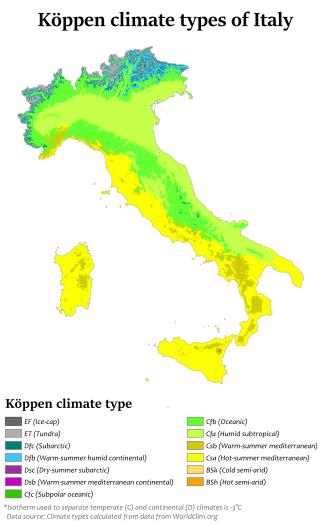
The climate of Italy is highly diverse. In most of the inland northern and central regions, the climate ranges from humid subtropical to humid continental and oceanic. The climate of the Po valley geographical region is mostly humid subtropical, with cool winters and hot summers.[1][2] The coastal areas of Liguria, Tuscany and most of the South experience a Mediterranean climate according to the Köppen climate classification.
Between the north and south there can be a considerable difference in temperature, above all during the winter: on some winter days it can be −2 °C (28 °F) and snowing in Milan, while it is 8 °C (46.4 °F) in Rome and 20 °C (68 °F) in Palermo. Temperature differences are less extreme in the summer. On 11 August 2021, an agricultural monitoring station near Syracuse recorded 48.8 °C (119.8 °F) which constitutes the official record of the highest temperature in Europe according to the World Meteorological Organization.[3]
Italy is experiencing widespread impacts of climate change, with an increase in extreme events such as heatwaves, droughts and more frequent flooding eg Venice is facing increasing issues due to sea level rise.[4][5] Italy faces many challenges adapting to climate change including the economic, social, and environmental impacts that climate change creates, and an increasingly problematic death toll from the health risks that come with climate change.[6][7]
- ^ Adriana Rigutti, Meteorologia, Giunti, p. 95, 2009.
- ^ Thomas A. Blair, Climatology: General and Regional, Prentice Hall pp. 131–132
- ^ Cite error: The named reference
wmowas invoked but never defined (see the help page). - ^ Umgiesser, Georg (April 2020). "The impact of operating the mobile barriers in Venice (MOSE) under climate change" (PDF). Journal for Nature Conservation. 54: 125783. Bibcode:2020JNatC..5425783U. doi:10.1016/j.jnc.2019.125783. S2CID 212790209. Retrieved 9 July 2022.
- ^ Levantesi, Stella (2 November 2021). "Assessing Italy's climate risk". Nature Italy. doi:10.1038/d43978-021-00136-0. S2CID 242053771.
- ^ "Italy — Climate-ADAPT". climate-adapt.eea.europa.eu. Retrieved 10 July 2022.
- ^ "Italy Faces National Climate Emergency to Add to Debt Woes". Bloomberg.com. 5 July 2022. Retrieved 9 July 2022.